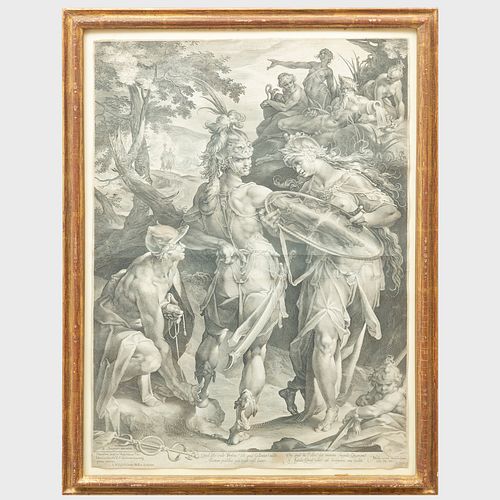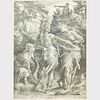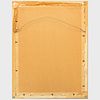Jan Müller (1571-1628), After Bartholomaeus Spranger (1546-1611): Minerva and Mercury Arming Perseus
Bid Increments
| Price | Bid Increment |
|---|---|
| $0 | $25 |
| $200 | $50 |
| $500 | $100 |
| $3,000 | $250 |
| $5,000 | $500 |
| $10,000 | $1,000 |
| $30,000 | $2,500 |
| $100,000 | $5,000 |
Engraving in black on laid paper, 1604.
22 1/8 x 15 3/4 in. (sheet), 25 1/4 x 19 in. (frame).
Note: Flemish painter Bartholomeus Spranger (1546-1611) was known for combining elements of Netherlandish painting with the Italian Mannerist aesthetic to create his own style known as Northern Mannerism. Spanger worked in Prague as the court painter for the Holy Roman Emperor Rudolf II (1552-1612), painting mythological scenes of eroticized nudes in nature and works that extolled Rudolf’s power as ruler. Rudolf II was described by a contemporary as the greatest patron of the arts in the world at that time, having raised court patronage of the arts to a new level of extravagance in post-Renaissance Europe. The Emperor not only commissioned works of art but offered direct support to artists, visiting them in their workshops and raising the status of the guild painters from craft to that of a liberal art. Spranger was one of the artists who enjoyed the benefits of Rudolf’s patronage, the two were known to be friends and spent much time together. Spanger’s reputation was furthered throughout Europe by other artists who made prints after his paintings, disseminating the images across the continent. One such artist was Jan Muller (1571-1628) who copied many of Spranger’s mythological compostions in a series of engravings. Minerva and Mercury Arming Perseus, from 1604, is an example of Spranger’s Northern Mannerist style and Jan Muller’s talent as an engraver. The image depicts the goddess Minerva and the god Mercury arming the Greek hero Perseus for his encounter with the monster Medusa. For this herculean battle, Mercury lent Perseus his winged sandals, Minerva lent him her shield, and Pluto lent his helmet of invisibility. Perseus used the reflection in Minerva’s shield to guide his killing blow to Medusa, thus creating the first of the Greek heroes to vanquish the monsters known as Medusa.
Literature: New Hollstein 69.






